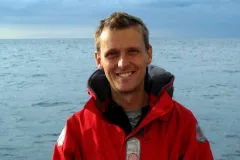Exploring the Blue Planet with J. Murray Roberts

Imagine you’re an alien seeing Planet Earth for the first time. What do you see from your spacecraft? A blue planet with over 70% of its surface covered by ocean. From space it’s obvious how important the ocean is to our planet. But we actually know very little about what lives at the bottom of the deep sea—including corals. Deep-sea corals include Earth’s oldest living animals. Some are more than 4,000-years-old. Since 2003 I’ve been studying and mapping an area in the North Atlantic where Lophelia grow at depths of up to 190 m (623 ft). I’m interested in what sustains the incredibly high diversity among deep-sea corals.
- How do they form where they do?
- How are they responding to human impacts?
- And how can we manage and conserve them?
Incredible Dives
To answer questions like these, I have to get out into the habitats where deep-sea corals live. Over the last 14 years I’ve been lucky enough to make a number of incredible dives to the bottom of the sea. One thing that amazes me is that even though areas where deep-sea corals live have never been seen before, many have been physically damaged. People fishing with bottom trawls have unknowingly destroyed habitats that took thousands of years to grow.
Although we’ve only scratched the surface of deep-sea coral diversity, researchers have already discovered valuable new drugs in corals and sponges. If we lose this diversity, future generations won’t be able to appreciate its beauty or benefit from drugs that will be discovered in the years to come.

